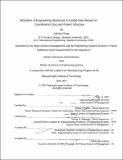| dc.contributor.advisor | Daniel Whitney and Steven D. Eppinger. | en_US |
| dc.contributor.author | Chang, Sabrina | en_US |
| dc.contributor.other | Leaders for Manufacturing Program. | en_US |
| dc.date.accessioned | 2007-11-15T21:35:06Z | |
| dc.date.available | 2007-11-15T21:35:06Z | |
| dc.date.copyright | 2007 | en_US |
| dc.date.issued | 2007 | en_US |
| dc.identifier.uri | http://hdl.handle.net/1721.1/39486 | |
| dc.description | Thesis (M.B.A.)--Massachusetts Institute of Technology, Sloan School of Management; and, (S.M.)--Massachusetts Institute of Technology, Engineering Systems Division; in conjunction with the Leaders for Manufacturing Program at MIT, 2007. | en_US |
| dc.description | This electronic version was submitted by the student author. The certified thesis is available in the Institute Archives and Special Collections. | en_US |
| dc.description | Includes bibliographical references (p. 75, 77). | en_US |
| dc.description.abstract | Because of the increasingly globalized world we live in, companies today are very interested in going overseas to develop and utilize global engineering resources. By doing so, they hope to take advantage of new global product development (GPD) enablers and motivators such as the internet, new collaborative information technology tools, access to new markets, and the increasing availability of low-cost engineering talent. While globalization has significantly decreased barriers so that more companies are hurrying to move engineering activities to its global sites, it is no secret that GPD teams pose significant coordination challenges. Cost savings from lower labor rates abroad can easily be eaten up by the increased coordination costs required to manage overseas interactions between local and global activities. This paper introduces a model that maps a project's coordination structure to help managers decide which activities should be allocated to a global site and which ones should be kept at home. It introduces a new multi-site coordination matrix based on the Design Structure Matrix and an optimization model that chooses where to locate activities to minimize project coordination costs. | en_US |
| dc.description.abstract | (cont.) A key principle the model relies on is the modularization of activities at each site for efficient organization design. This method was employed to design a GPD plan for the Advanced Manufacturing Engineering department at Honeywell Aerospace. | en_US |
| dc.description.statementofresponsibility | by Sabrina Chang. | en_US |
| dc.format.extent | 77 p. | en_US |
| dc.language.iso | eng | en_US |
| dc.publisher | Massachusetts Institute of Technology | en_US |
| dc.rights | M.I.T. theses are protected by copyright. They may be viewed from this source for any purpose, but reproduction or distribution in any format is prohibited without written permission. See provided URL for inquiries about permission. | en_US |
| dc.rights.uri | http://dspace.mit.edu/handle/1721.1/7582 | |
| dc.subject | Sloan School of Management. | en_US |
| dc.subject | Engineering Systems Division. | en_US |
| dc.subject | Leaders for Manufacturing Program. | en_US |
| dc.title | Allocation of engineering resources to global sites based on coordination cost and project structure | en_US |
| dc.type | Thesis | en_US |
| dc.description.degree | S.M. | en_US |
| dc.description.degree | M.B.A. | en_US |
| dc.contributor.department | Leaders for Manufacturing Program at MIT | en_US |
| dc.contributor.department | Massachusetts Institute of Technology. Engineering Systems Division | |
| dc.contributor.department | Sloan School of Management | |
| dc.identifier.oclc | 174972371 | en_US |

